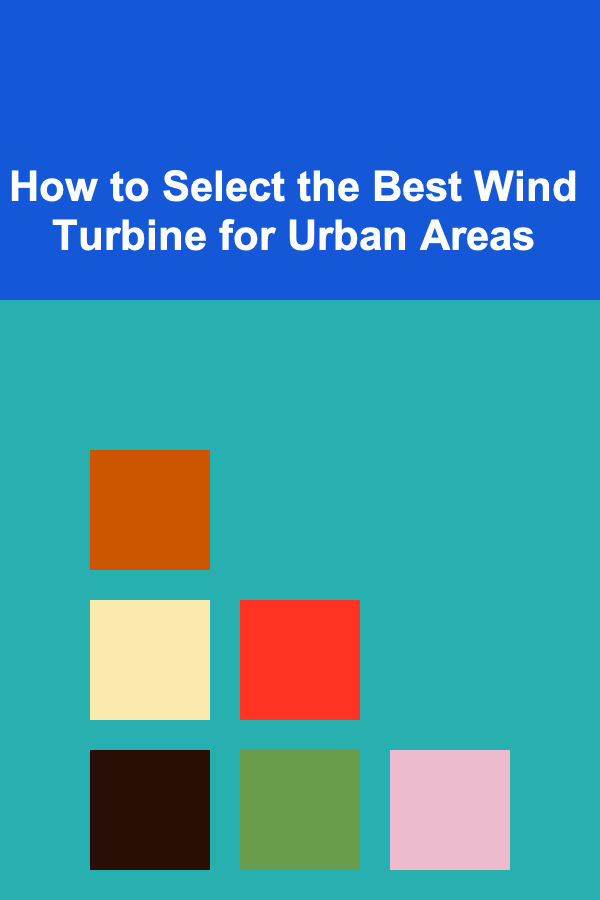
How to Select the Best Wind Turbine for Urban Areas
ebook include PDF & Audio bundle (Micro Guide)
$12.99$8.99
Limited Time Offer! Order within the next:

Wind energy is increasingly recognized as a sustainable source of power that can help reduce reliance on fossil fuels and combat climate change. While most wind turbines are installed in rural or offshore locations where wind conditions are optimal, urban areas are also exploring the possibility of harnessing wind energy. The challenge lies in selecting the right wind turbine that can effectively operate in urban environments, where wind conditions are often unpredictable, space is limited, and aesthetic concerns play a role.
In this article, we will discuss the factors that need to be considered when selecting the best wind turbine for urban areas. By examining aspects such as wind resources, turbine design, noise, and installation space, we will help you navigate the complexities of selecting the right wind turbine for an urban setting.
Understanding Wind Resources in Urban Areas
Urban Wind Patterns
Urban areas present unique challenges for wind energy generation due to their complex wind patterns. The presence of tall buildings, narrow streets, and other obstructions can create turbulence and unpredictable wind flows, which are not ideal for traditional wind turbines. However, some areas in cities can still experience consistent wind speeds, particularly in locations near the coast, hilltops, or on rooftops where wind flows are less obstructed.
In general, wind in urban environments tends to be more turbulent and less predictable than in rural or open areas. As a result, the wind speed is often lower, and gusts can cause inefficiency in energy production. It is critical to use wind measurements, such as wind speed and direction, taken at the intended installation site over a period of time to better understand the potential for wind energy production.
Importance of Wind Resource Assessment
Before selecting a wind turbine for an urban environment, it is important to conduct a thorough wind resource assessment. This can be done through the use of an anemometer to measure average wind speeds and direction at the specific location. Wind maps or data from nearby weather stations can also be helpful in determining the overall wind potential in the area.
Since urban wind conditions are more variable and turbulent, turbines that are designed to perform well in such conditions---often referred to as "low wind" or "urban turbines"---are required. These turbines are built to operate efficiently even with lower wind speeds and are equipped with advanced features to handle turbulent wind flows.
Choosing the Right Type of Wind Turbine for Urban Areas
Horizontal Axis Wind Turbines (HAWTs)
Horizontal axis wind turbines (HAWTs) are the most common and widely recognized type of wind turbine. These turbines feature large blades that rotate around a horizontal axis. They are typically used in rural or offshore locations where wind resources are abundant. However, due to their size and requirements for large open spaces, HAWTs are often not suitable for urban areas.
Although some small-scale HAWTs exist, they still require significant open space, which may be difficult to find in a city setting. Additionally, the noise generated by the blades in a horizontal configuration can be disruptive in densely populated urban areas.
Vertical Axis Wind Turbines (VAWTs)
Vertical axis wind turbines (VAWTs) are an increasingly popular option for urban environments. Unlike their horizontal counterparts, VAWTs have blades that rotate around a vertical axis, allowing them to capture wind from any direction. This feature makes VAWTs particularly suited for urban areas where wind direction can be highly variable and unpredictable.
VAWTs also tend to have a smaller footprint than HAWTs, making them easier to install in confined urban spaces such as rooftops or between buildings. Their design minimizes the visual impact and reduces the noise produced, which is crucial in maintaining the quality of life in densely populated areas.
There are several types of VAWTs, including:
- Darrieus Turbines: These turbines have curved blades and are highly efficient but typically require a high starting speed to begin operating. They are best suited for locations with consistent wind.
- Savonius Turbines: These turbines have a simple design with scooped blades and are less efficient than Darrieus turbines. However, they are ideal for areas with low and turbulent wind speeds and are commonly used in urban environments.
Hybrid Wind Turbines
Some modern turbines combine both horizontal and vertical axis designs to offer a more versatile solution for urban settings. Hybrid turbines can capture wind from multiple directions and are optimized to handle varying wind speeds and turbulence. These turbines may be a good choice for urban areas where wind conditions are inconsistent and change rapidly.
Key Considerations in Selecting Turbine Type
When selecting a wind turbine for urban areas, there are several factors to consider regarding turbine type:
- Wind Speed Requirements: Consider turbines that are designed to generate energy at lower wind speeds, especially in cities where wind speeds tend to be lower than in rural areas.
- Turbine Size: Urban areas often lack the space for large-scale turbines, so opting for compact, small-scale turbines is necessary. VAWTs and hybrid turbines generally have smaller profiles and are more space-efficient than traditional HAWTs.
- Noise Levels: Noise pollution is a significant concern in urban settings. VAWTs are generally quieter than HAWTs, making them a better choice in areas where noise reduction is crucial.
Assessing Noise and Aesthetic Impact
Noise Considerations in Urban Areas
One of the most critical factors when choosing a wind turbine for an urban area is the noise it produces. Traditional wind turbines, particularly HAWTs, can generate significant noise due to the movement of the blades through the air. This can be disruptive in urban environments, where noise pollution is already a concern.
VAWTs tend to produce less noise than HAWTs, making them a more suitable choice for urban environments. However, it is still important to evaluate the noise levels of specific turbine models, especially if they are intended for use in densely populated residential areas.
To minimize noise pollution, consider the following:
- Distance from Residential Areas: Installing turbines at a reasonable distance from residential areas or other sensitive spaces can help reduce noise impact.
- Turbine Design: Look for turbines specifically designed to operate quietly. Manufacturers may provide specifications regarding noise levels and the operational decibel range of the turbines.
- Maintenance: Regular maintenance of the turbine can help prevent mechanical issues that could lead to excess noise or malfunctioning parts.
Aesthetic Concerns
Wind turbines can be visually striking, which can be an issue in urban areas where aesthetic considerations play a significant role in the acceptance of renewable energy solutions. Urban residents may be concerned about the visual impact of large turbines on cityscapes and architecture.
The compact and less visually obtrusive nature of VAWTs makes them an attractive option for urban settings. They can be installed on rooftops or integrated into building designs without compromising the city's appearance. Hybrid turbines, which combine elements of both horizontal and vertical axis designs, may also offer a more aesthetically pleasing alternative.
When selecting a wind turbine for an urban area, it's important to engage with local communities and city planners to assess the visual impact of the installation and ensure that it aligns with the area's aesthetic and cultural values.
Space Availability and Installation Considerations
Rooftop Installations
In cities, space is often limited, and finding the right location for a wind turbine can be challenging. Rooftop installations are among the most popular options for urban wind energy generation, as they make use of otherwise unused space and can avoid conflicts with other land uses.
When considering a rooftop installation, the following factors should be taken into account:
- Roof Size and Structural Integrity: Ensure that the rooftop is large enough to accommodate the turbine and that the structure can support the weight and vibration of the turbine during operation.
- Access to Wind: The location of the building within the urban area can impact the wind resources available. Tall buildings and surrounding structures may cause wind turbulence, so it is important to assess the wind flow patterns before installation.
- Building Codes and Zoning Regulations: Consult with local authorities to ensure that the turbine installation complies with building codes, zoning laws, and any regulations related to noise or aesthetics.
Ground-Mounted Installations
Ground-mounted wind turbines are typically used in rural settings, but they can also be considered for urban areas with available land, such as public parks or industrial zones. The primary challenge with ground-mounted installations in urban areas is finding sufficient space, as most urban environments are highly developed and densely populated.
When evaluating the feasibility of ground-mounted wind turbines, consider factors such as:
- Land Availability: Identify areas with unused or underutilized land that could accommodate a turbine installation.
- Accessibility: Ensure that the turbine is easily accessible for installation and maintenance.
- Community Acceptance: Ground-mounted turbines in urban areas may face resistance from local communities due to concerns about visual impact, noise, and land use.
Environmental and Economic Considerations
Environmental Impact
While wind energy is a clean and renewable source of power, it is important to evaluate the environmental impact of installing a turbine in an urban area. Consider the following:
- Impact on Wildlife: Ensure that the turbine does not negatively impact local wildlife, particularly birds and bats, which may be at risk from turbine blades.
- Sustainability of Materials: Choose a turbine made from sustainable materials that can be easily recycled or disposed of at the end of its life cycle.
- Carbon Footprint: Consider the overall carbon footprint of manufacturing and installing the turbine, including transportation and construction impacts.
Economic Considerations
The cost of purchasing and installing a wind turbine in an urban environment can vary depending on the turbine type, installation complexity, and local regulations. While the initial investment may be high, wind turbines can provide long-term savings on electricity bills and contribute to a more sustainable urban environment.
It is also worth exploring government incentives, grants, or subsidies for renewable energy projects in urban areas, as these can help reduce upfront costs.
Conclusion
Selecting the best wind turbine for an urban area involves a thorough assessment of wind resources, turbine design, noise considerations, space availability, and environmental impact. Vertical axis wind turbines and hybrid models are particularly well-suited for urban environments due to their ability to operate efficiently in turbulent and low-wind conditions. Additionally, VAWTs tend to be quieter and more compact, making them a better fit for densely populated areas.
By carefully considering these factors and working with local communities and city planners, urban areas can take significant steps toward incorporating wind energy into their renewable energy portfolios. Wind power in cities is not only a feasible solution but also an important step toward creating more sustainable, energy-efficient urban environments.

Beginner Guide: The Guide to Healthy Eating
Read More
Make Money by Creating and Selling Deep Learning APIs
Read More
How to Support First Responders' Mental Health
Read More
How To Combat Dullness and Lack of Radiance
Read More
How to Incorporate More Legumes into Your Diet
Read More
How to Find a Surgeon with Experience in a Rare Procedure
Read MoreOther Products

Beginner Guide: The Guide to Healthy Eating
Read More
Make Money by Creating and Selling Deep Learning APIs
Read More
How to Support First Responders' Mental Health
Read More
How To Combat Dullness and Lack of Radiance
Read More
How to Incorporate More Legumes into Your Diet
Read More